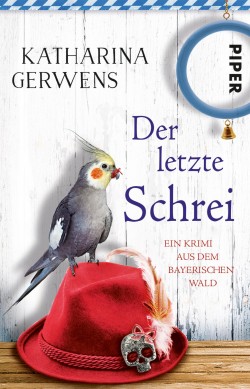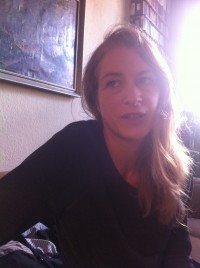The first novel to state in black and white that the author worked with Beemgee.
This is certainly not the first book for which our author tool was used. But it is the first time that an author explicitly mentions Beemgee in her acknowledgements. Thank you, Katharina, we’re glad you use Beemgee during your story development!
 All The Rage – Der letzte Schrei
All The Rage – Der letzte Schrei
published by the renowned Piper Verlag (Bonnier group)
Susanne Pfeiffer has recently joined the Beemgee team. She interviewed her long-time friend Katharina Gerwens for us.
Congratulations, Katharina! It’s always great when you can hold your own book in your hands … How many novels have you published so far?
This is my eleventh regional thriller published by Piper. Soon I’ll make it a dozen ….
I think ALL THE RAGE is a really good thriller title! You like double meanings. – But I want to get at something completely different: You know my foible to start every book by reading the acknowledgements – and here it says, last but not least, you worked on the plot with BEEMGEE! How so?
Because for me any support I get is worth mentioning! I have asked so many people in my field about all sorts of things, and in these conversations new aspects have always emerged – the least I can so is say thank you! ALL THE RAGE is, by the way, the first book in which I worked with Beemgee – and it was a great help to me. (more…)
Reflections on dialectically guided writing, or: Can dialectics help us tell better stories?
 Guest post by Richard Sorg.
Guest post by Richard Sorg.
Prof. Dr. phil. Richard Sorg, born in 1940, is an expert in dialectics. What is that, and what does it have to do with my novel? Well, “All great, moving and convincing stories are inconceivable without the central significance of the contradictions and conflicts that represent the driving energy of movement and development.” This puts us in the middle of dialectics. And of storytelling.
After studying theology, sociology, political science and philosophy in Tübingen, West Berlin, Zurich and Marburg, Richard Sorg taught sociology in Wiesbaden and Hamburg. His book “Dialectical Thinking” was recently published by PapyRossa Verlag. (Photo: Torsten Kollmer)
Ideas that contain a potential for conflict.
Sometimes there is a single but central chord at the beginning of a piece of music, even an entire opera, which is then gradually unfolded. Its inherent aspects, harmonies and dissonances emerge from the chosen, sometimes inconspicuous beginning, undergoing a dramatic, conflictual development, so that a whole, complex story emerges at the end of the path of this simple chord after its unfolding. This is the case, for example, with the so-called Tristan chord at the beginning of Richard Wagner’s opera “Tristan und Isolde”, a leitmotif chord that ends with an irritating dissonance.
The beginning of a story is sometimes an idea, an idea which you may not know how to develop. But some such ideas or beginnings carry a potential within them that is capable of unfolding and which holds unimagined development possibilities. ‘Candidates’ for viable beginnings – comparable to the dissonant Tristan chord mentioned above – are those that contain a potential for conflict or contradiction within. But it can also be a calm with which the matter is opened up, a calm that may then prove to be deceptive. We also find something similar in some dramas, for example with Bertolt Brecht.
And with that, we are already in the middle of dialectics. (more…)
What do we mean when we talk about story structure?
A story is a complex entity comprising many interrelating parts. The author imposes some sort of organising principle onto the material, turning the story into a narrative. The result of this forming or shaping of the material is the story structure.
Certain structural markers are so explicit that the audience is aware of them, such as chapters in novels. Elizabethan plays are typically divided into five acts. A film script is broken down into acts, sequences, and scenes.
Beats
But there are structures that are not usually made obvious or explicit. For example, a scene may be broken down into beats – marked only by the moments when the mood or relationship the scene describes changes. Two characters are having a conversation, character A says something which makes character B react in a different way from what A expected – that’s a beat.
The term beat is also sometimes used when marking such changes on a bigger scale, across an entire narrative. Some screenwriters work with so-called beat sheets; in the Beemgee outlining tool, the plot event cards are perfect for creating beat sheets, since each card is designed to stand for one plot event. In a beat sheet, a beat is one unit of plot. If you think of narrative as a chain of events, then each beat is a single link. In one school of thought, a Hollywood movie is ideally constructed of exactly 40 such beats. (more…)
UPDATE: The winner is … Call for story outlines by Beemgee, Ink-it and CONTEC México 2017.


This is Yolanda Prieto Pardo, whose story outline LOS ALTOS VUELOS DE JOSEFINA was chosen in the Fiction without Friction contest we ran with Contec México and Ink it. She has won a lifetime subscription to Beemgee Premium. Furthermore, our friends at Ink it will publish the novel online all over the world in 85 countries.
Congratulations Yolanda!
The CONTEC/Beemgee “Fiction without Friction” call for stories
Many innovations relevant to authors of stories and “content” apply to publication and distribution. However, digital aids can also help creators right from the moment they have their first ideas.
With Beemgee.com, fiction authors have a tool that helps them organize their plots and develop their characters. When it comes to pitching the work to a publisher, a Beemgee project provides a powerful supplement to the traditional exposé.
For publishers and other content disseminating organizations, Beemgee is a new tool that increases productivity during the evaluation process and considerably improves the workflow between author and editor/producer/publisher.
To showcase this new approach, CONTEC and Beemgee are running a call for stories, which the ebook platform ink-it is supporting.
Turn your story into a book for sale in over 40 online stores! (more…)

Author and creative writing teacher Jesse Falzoi was born in Hamburg and raised in Lübeck, Germany. Back in the nineties, after stays in the USA and France, she moved to Berlin, where she still lives with her three children.
She has translated Donald Barthelme stories into German. Her own stories have appeared in American, Russian, Indian, German, Swiss, Irish, British and Canadian magazines and anthologies. She holds an MFA in Creative Writing from Sierra Nevada College.
Her new book on Creative Writing is released end of May 2017.
At the age of twenty-one I quit university and bought a one-way ticket to San Francisco, USA. I wanted to get far away from my first attempts to grow up. I wanted to get away from a frustrating relationship and boring courses and everything that was pushing me to take life more seriously. I didn’t have any plans what I would be doing in San Francisco but I had the address of an acquaintance I had made a year before. I went on a journey that was physical in the beginning and became more and more spiritual during the process. I bought a return ticket in the end and went back to my hometown just to pack my suitcases for good; I’d be staying in Germany, but I wouldn’t be staying home.
(more…)
Conflict is the lifeblood of story.
In real life, conflict is something we generally want to avoid. Stories, on the other hand, require conflict. This discrepancy is an indicator of the underlying purpose of stories as a kind of training ground, a place where we learn to deal with conflict without having to suffer real-life consequences.
In this post we will look at:
- An Analogy
- Archetypal conflict in stories
- Conflict between characters
- Conflict within a character
- The central conflict
Along with language (in some form or other, be it as text or as the language of a medium, such as film) and meaning (intended by the author or understood by the recipient), characters and plot form the constituent parts of story. It is impossible to create a story that does not include these four components – even if the characters are one-dimensional and the plot has no structure. However, it is formally possible to compose a story with no conflict.
It just won’t be very interesting.
(more…)
The term motif refers to any recurring element – in storytelling as in music or other arts.
Examples of elements that turn up repeatedly within a whole are an image on a tapestry or a particular sequence of notes in a symphony. The dispersal of these elements creates a pattern. It is therefore part of the artist’s craft to have some sort of design principle determine this pattern.
What motifs do
Motifs do not make a plot. But since they make patterns they are part of the structure of a story. And they help add a layer of meaning.
In other words, if a motif is present excessively in the first half of a story, and hardly at all in the second, then the author had better be aware of a reason for this uneven distribution. The distribution – the pattern – carries meaning to the audience. Remember, the audience yearns for meaning, is always striving to understand what the story is trying to convey at any given point. This demand for some sort of raison d’être for each element of a story, or for a sense of order within the whole, may well be unconscious to the audience much of the time, but ultimately the experience of the story is more satisfying when the audience can work out reasons and meaning.
In stories, motifs can be almost anything. Objects, actions, metaphors, symbols, colours, or images can be motifs. What defines an element as a motif is the systematic deployment within the story rather than the thing itself.
How motifs work
Motifs work best when(more…)
Detectives and other investigators abound on our TV and cinema screens.
In the western world, crime fiction – mystery, thrillers, suspense, etc. – makes up somewhere between 25 and 40 percent of all fiction book sales. Why is the crime genre so popular?
Crime is fascinating, to be sure, because most of us don’t commit it. But the popularity of the genre has little to do with crime per se. It has far more to do with the very essence of how storytelling works.
In this article we will be looking at:
- Cause and Effect
- Agency
- The Narrative Principle
- Why Some People Don’t Like Crime Stories
- The Search For Truth
- How Crime Is Like Comedy
Crime fiction exhibits most clearly one of the fundamental rules of storytelling: cause and effect. In crime fiction,(more…)
Archetypes in stories express patterns.
While plots may be “archetypal” when they exhibit certain forms, in this post we are concerned with character archetypes.
In modern storytelling, to consider them as archetypes might suggest a bit of a corset, perhaps even a straightjacket for the characters. For today’s author, to present a character as an archetype does not seem conducive to achieving psychological verisimilitude.
But an archetype is not the same as a stereotype. An advisor or mentor does not need to be a wise old man like Obi-Wan Kenobi. And an antagonist does not need to be a baddy.
Consider archetypes as powers within a story. Like planets in a solar system, they have gravity and they therefore exert force as they move.
Archetypes denote certain general roles or functions for characters within the system of the story. There is ample room for variation within each role or function. Boundaries between one archetype and another may be fuzzy. And it is possible for one character to stand for more than one archetype.
Archetypes Through The Ages
(more…)
 All The Rage – Der letzte Schrei
All The Rage – Der letzte Schrei
 Guest post by Richard Sorg.
Guest post by Richard Sorg.

